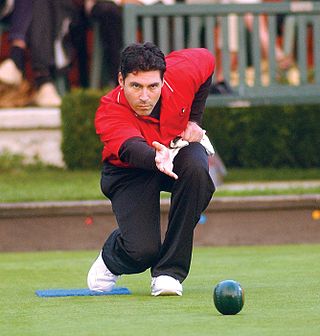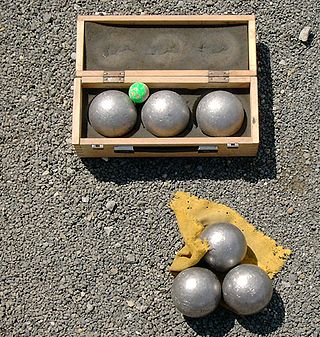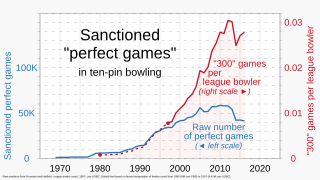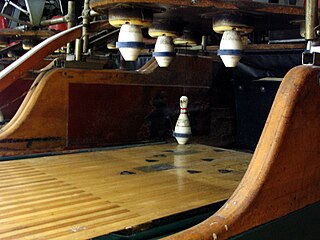
Bowls, also known as lawn bowls or lawn bowling, is a sport. Players try to roll their ball closest to a smaller ball. The bowls are heavier on one side so that they turn when being rolled. The game is played either in teams or one against one.

Boules, or jeu de boules, is a collective name for a wide range of games similar to bowls and bocce in which the objective is to throw or roll heavy balls as closely as possible to a small target ball, called the jack. 'Boules' itself is a French loanword that usually refers to the game especially played in France.

Five-pin bowling is a bowling variant which is played in Canada, where many bowling alleys offer it, either alone or in combination with ten-pin bowling. It was devised around 1909 by Thomas F. Ryan in Toronto, Ontario, at his Toronto Bowling Club, in response to customers who complained that the ten-pin game was too strenuous. He cut five tenpins down to about 75% of their size, and used hand-sized hard rubber balls, thus inventing the original version of five-pin bowling.

Ten-pin bowling is a type of bowling in which a bowler rolls a bowling ball down a wood or synthetic lane toward ten pins positioned evenly in four rows in an equilateral triangle. The objective is to knock down all ten pins on the first roll of the ball, or failing that, on the second roll. While most people approach modern ten-pin bowling as a simple recreational pastime, those who bowl competitively, especially at the highest levels, consider it a demanding sport requiring precision and skill.

Skittles is a historical lawn game and target sport of European origin, from which the modern sport of nine-pin bowling is descended. In regions of the United Kingdom and Ireland the game remains as a popular indoor pub game.

Candlepin bowling is a variation of bowling that is played primarily in the Canadian Maritime provinces and the New England region of the United States. It is played with a handheld-sized ball and tall, narrow pins that resemble candles, hence the name.

Duckpin bowling is a variation of the sport of bowling.

A perfect game is the highest score possible in a game of bowling, achieved by scoring a strike with every throw. In bowling games that use 10 pins, such as ten-pin bowling, candlepin bowling, and duckpin bowling, the highest possible score is 300, achieved by bowling 12 strikes in a row in a traditional single game: one strike in each of the first nine frames, and three more in the tenth frame.

In bowling, a pinsetter or pinspotter is an automated mechanical device that sets bowling pins back in their original positions, returns bowling balls to the front of the alley, and clears fallen pins on the pin deck. Prior to the machine's invention, pinsetters were boys or young men hired at bowling alleys to manually reset pins and returned balls to the player. The first mechanical pinsetter was invented by Gottfried (Fred) Schmidt, who sold the patent in 1941 to AMF. Pinsetting machines have largely done away with pinsetting as a manual profession, although a small number of bowling alleys still uses human pinsetters. While humans usually no longer set the pins, a pinchaser is often stationed near the equipment to ensure it is clean and working properly, and to clear minor jams.
The following is a glossary of traditional English-language terms used in the three overarching cue sports disciplines: carom billiards referring to the various carom games played on a billiard table without pockets; pool, which denotes a host of games played on a table with six pockets; and snooker, played on a large pocket table, and which has a sport culture unto itself distinct from pool. There are also games such as English billiards that include aspects of multiple disciplines.
Traditionally, tennis is played between two people in a singles match, or two pairs in a doubles match. Tennis can also be played on different courts, including grass courts, clay courts, hard courts, and artificial grass courts.
Bolas criollas is a traditional team sport from Venezuela, very popular in the Llanos and most rural regions. It is one of the most representative icons of Llanero culture. Its origins can be traced back to traditional European boules sports, such as bocce and pétanque.
Chicago is a "money ball" pool gambling game.

Five-pin billiards or simply five-pins or 5-pins, is today usually a carom billiards form of cue sport, though sometimes still played on a pocket table. In addition to the customary three balls of most carom games, it makes use of a set of five upright pins (skittles) arranged in a "+" pattern at the center of the table. The game is popular especially in Italy and Argentina, but also in some other parts of Latin America and Europe, with international, televised professional tournaments. It is sometimes referred to as Italian five-pins or Italian billiards, or as simply italiana. A variant of the game, goriziana or nine-pins, adds additional skittles to the formation. A related pocket game, with larger pins, is played in Scandinavia and is referred to in English as Danish pin billiards, with a Swedish variant that has some rules more similar to the Italian game.

In bowling, a strike means that all of the pins have been knocked down on the first ball roll of a frame. On a bowling scoresheet, a strike is marked by an "X".

Nine-pin bowling is a bowling game played primarily in Europe. European championships are held each year. In Europe overall, there are some 130,000 players. Nine-pin bowling lanes are mostly found in Austria, Czech Republic, Slovakia, Belgium, Germany, Luxembourg, the Netherlands, Estonia, Switzerland, Serbia, Slovenia, Croatia, Poland, North Macedonia, Hungary, France, Brazil and Liechtenstein.

Bowling is a target sport and recreational activity in which a player rolls a ball toward pins or another target. The term bowling usually refers to pin bowling, though in the United Kingdom and Commonwealth countries, bowling could also refer to target bowling, such as lawn bowls.

Rolle bolle, also known as Belgian bowling or krulbollen, is a bowling sport related to boules, and originates from the Flanders region of Belgium. The sport was introduced to North America in the late 19th and early 20th centuries and is played in some rural areas of the Midwest and Prairie regions of the United States and Canada.

Stoßpudel is an historical, south German and Austrian pinball game in which a ball is projected onto an inclined wooden playing board and falls into hollows or rolls into demarcated slots. Various points are scored for each shot depending on where the ball ends up. An 1834 Bavarian dictionary describes a Stoßpudel as a "portable bowling alley, roughly like a type of billiard table, onto which an ivory ball is struck with a stick.".















